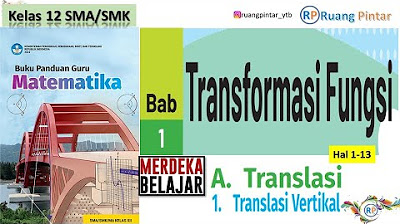Fungsi Linier Hal 59-63 Bab 3 Kelas 8 Kurikulum Merdeka Belajar
Summary
TLDRThis video lesson covers linear functions as outlined in Chapter 3 of the Grade 8 Merdeka Curriculum textbook. It explains how to analyze relationships between variables that change and express them as equations. The lesson uses examples like stalactite growth, temperature changes with altitude, and burning incense sticks to demonstrate linear functions. The key equation format discussed is y = ax + b, where 'a' is the rate of change and 'b' is the constant. Real-world applications, such as speed calculations and circle area formulas, are used to highlight both linear and non-linear functions.
Takeaways
- 📘 The video covers linear functions as per Chapter 3 of the 8th grade curriculum, based on pages 59-63 of the Merdeka curriculum textbook.
- 📏 The main learning objective is for students to analyze relationships between pairs of changing quantities and express them in equation form.
- 📐 An example involves calculating the growth of a stalactite, which is 5 cm long and grows by 1 cm every 30 years. The relationship between time and length is expressed as y = (1/30)x + 5.
- 📊 After 60 years, the stalactite's length becomes 7 cm, and it would take 300 years for the stalactite to grow to 15 cm, which can be calculated using the linear equation.
- 🧮 The general form of a linear function is y = ax + b, where 'a' represents the rate of change, and 'b' represents the starting value.
- 🌡️ Another example discusses how temperature decreases by 6°C for every kilometer increase in altitude, expressed as y = -6x + 18, showing a linear relationship.
- 🕯️ A third example shows the relationship between the burning time of incense and its remaining length, with the equation y = -0.5x + 14, where 0.5 cm is lost each minute.
- 📏 A rectangle's perimeter can be calculated using the linear equation y = 2x + 12, where 'x' is the width, showing another linear function example.
- 🏃♂️ Speed can be determined by dividing distance by time, shown in the example y = 28/x, which does not represent a linear function.
- 💡 The video emphasizes the efficiency of using linear equations over tables when solving problems involving large numbers, like 300 years of growth for the stalactite.
Q & A
What is the primary topic of the lesson in the video transcript?
-The primary topic is linear functions, specifically analyzing relationships between quantities that change over time and expressing them as linear equations.
What is the linear equation used to describe the growth of a stalactite after X years?
-The equation is y = (1/30)x + 5, where y represents the length of the stalactite in cm after X years.
How much does the stalactite grow every 30 years?
-The stalactite grows 1 cm every 30 years.
How long will the stalactite be after 60 years?
-After 60 years, the stalactite will be 7 cm long, according to the equation y = (1/30)x + 5.
How long will it take for the stalactite to reach 15 cm?
-It will take 300 years for the stalactite to reach 15 cm, as calculated using the equation y = (1/30)x + 5.
What is the general form of a linear function?
-The general form of a linear function is y = Ax + B, where A and B are constants, and A ≠ 0.
In the example of air temperature changes, how is the relationship between altitude and temperature expressed?
-The relationship is expressed as y = -6x + 18, where y is the temperature in degrees Celsius and x is the altitude in kilometers. The temperature decreases by 6°C for every 1 km increase in altitude.
How is the length of an incense stick modeled as it burns over time?
-The length of the incense stick is modeled by the equation y = -0.5x + 14, where y is the length of the stick in cm and x is the time in minutes. The stick loses 0.5 cm every minute.
What is the equation for the perimeter of a rectangle with a length of 6 cm and a variable width x?
-The equation for the perimeter of the rectangle is y = 2x + 12, where y represents the perimeter in cm.
Is the function for calculating a discounted price linear?
-Yes, the function y = (4/5)x, where y is the discounted price and x is the original price, is linear, as it follows the form y = Ax.
Outlines

Cette section est réservée aux utilisateurs payants. Améliorez votre compte pour accéder à cette section.
Améliorer maintenantMindmap

Cette section est réservée aux utilisateurs payants. Améliorez votre compte pour accéder à cette section.
Améliorer maintenantKeywords

Cette section est réservée aux utilisateurs payants. Améliorez votre compte pour accéder à cette section.
Améliorer maintenantHighlights

Cette section est réservée aux utilisateurs payants. Améliorez votre compte pour accéder à cette section.
Améliorer maintenantTranscripts

Cette section est réservée aux utilisateurs payants. Améliorez votre compte pour accéder à cette section.
Améliorer maintenantVoir Plus de Vidéos Connexes

Penyelesaian Sistem Persamaan Linear Dua Variabel (SPLDV) dengan Metode Grafik.

(Part 1) FUNGSI KOMPOSISI DAN FUNGSI INVERS MATEMATIKA SMA KELAS 11 #kurikulummerdeka #matematikasma

#1 Berpikir Komputasional Kelas 8 (Fungsi-Algoritma-Struktur Data) - Kumer | Pelajar Hebat

Pengertian Kemiringan Hal 235-238 Bab 5 Persamaan Garis Lurus Kelas 8 Kurikulum Merdeka Belajar

Translasi Vertikal Hal 1-13 Bab 1 TRANSFORMASI FUNGSI Kelas 12 SMA SMK Kurikulum Merdeka

SOAL LATIHAN BAB 4 LISTRIK MAGNET DAN SUMBER ENERGI ALTERNATIF (IPA Kelas 9 Kurikulum Merdeka)
5.0 / 5 (0 votes)
